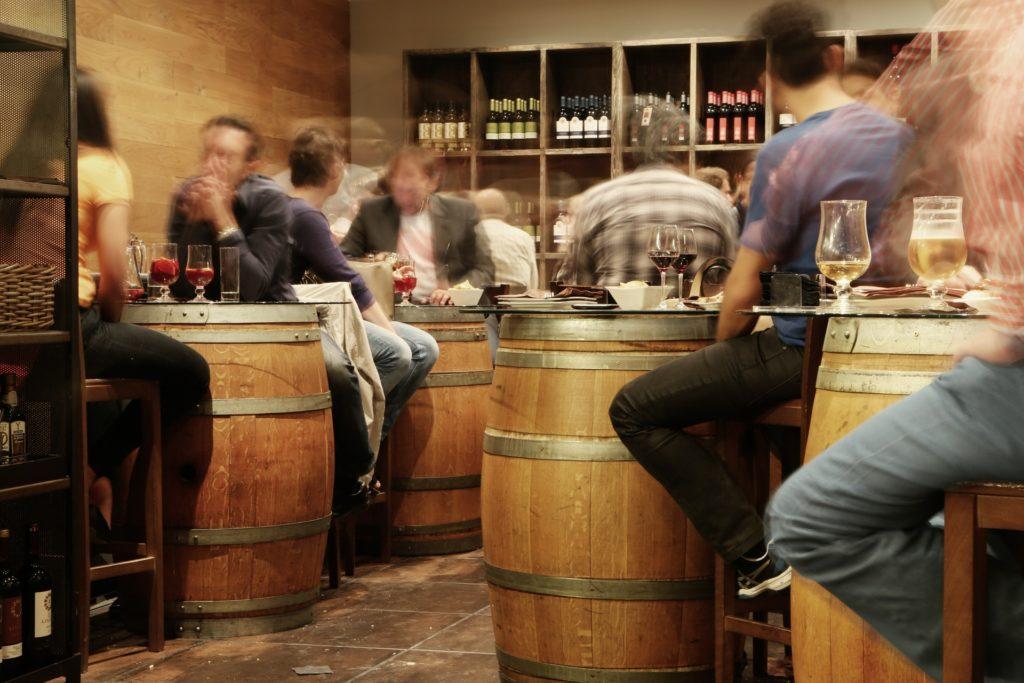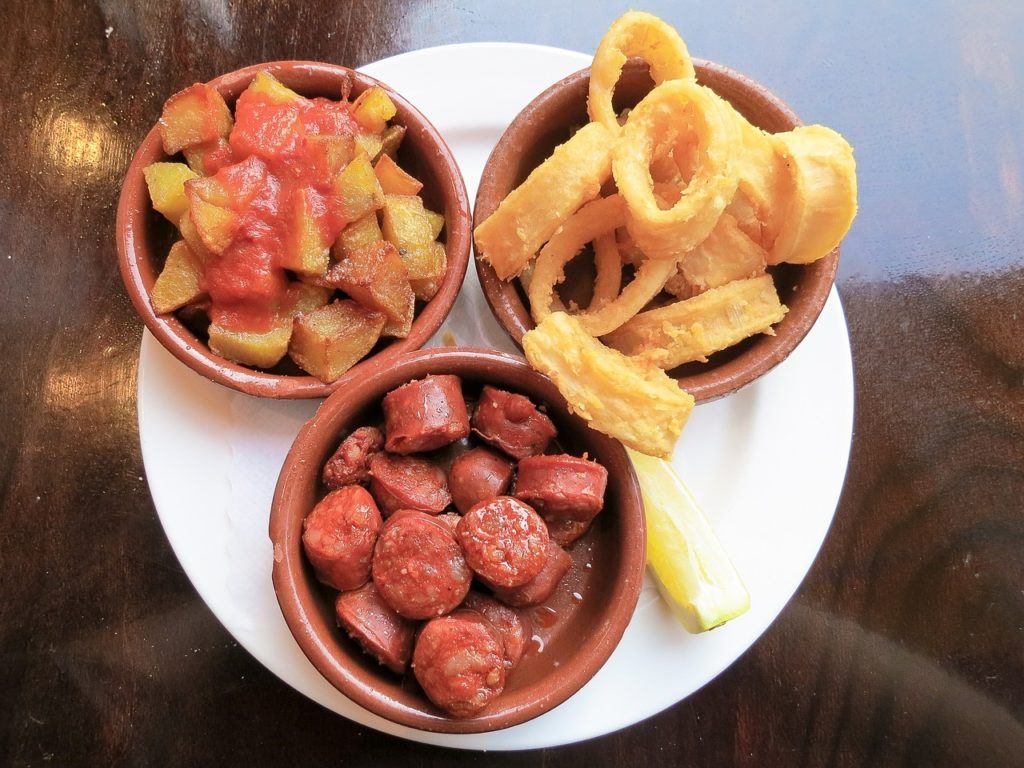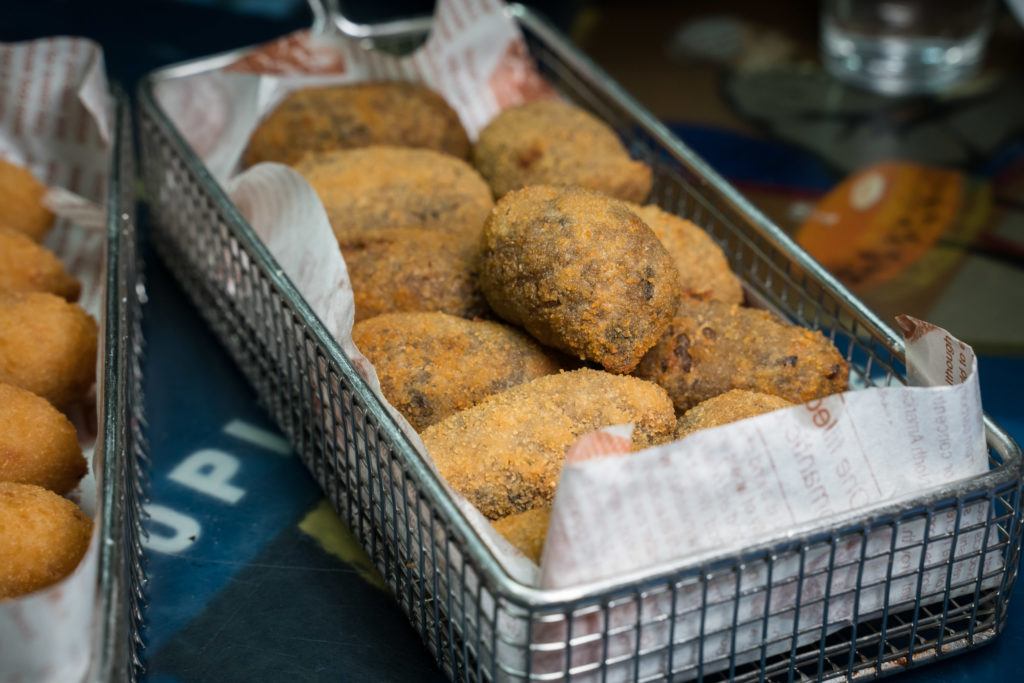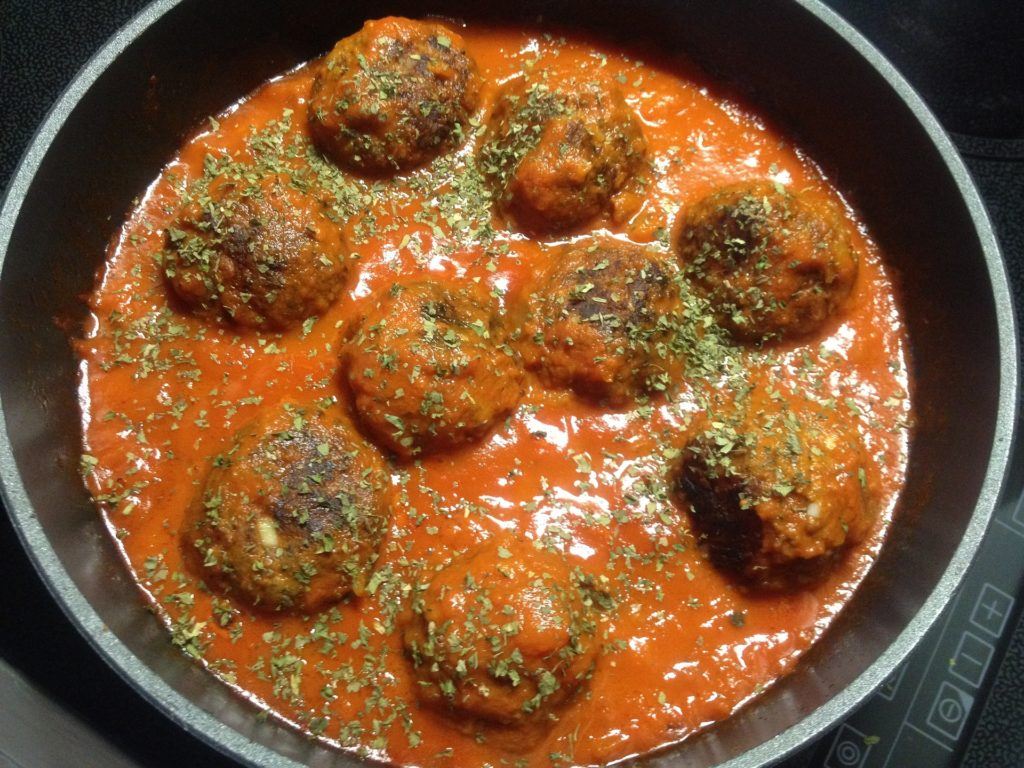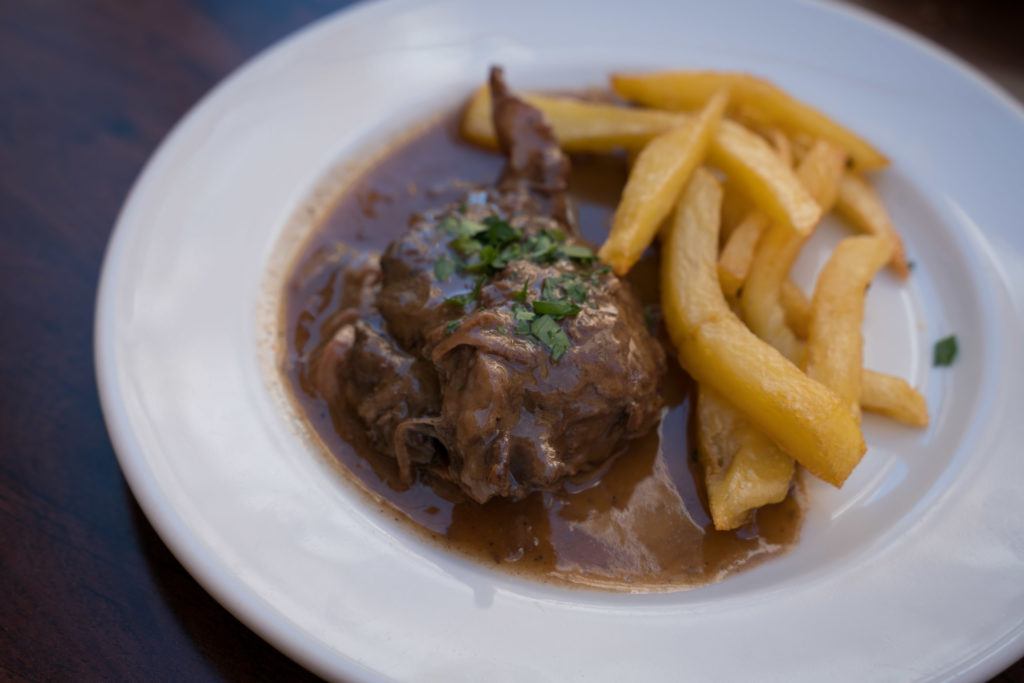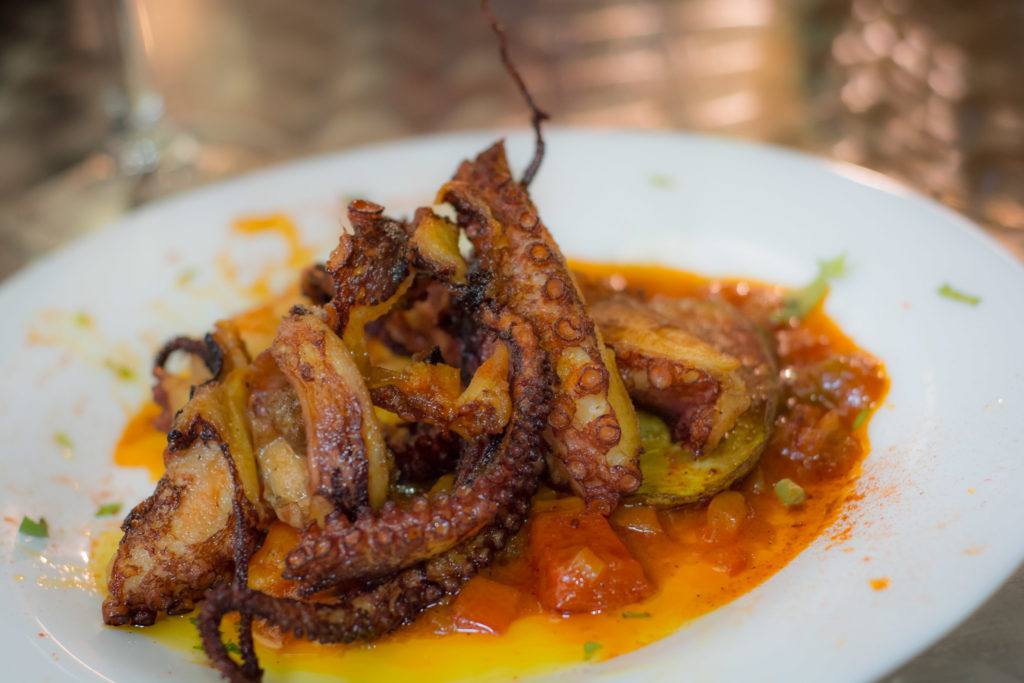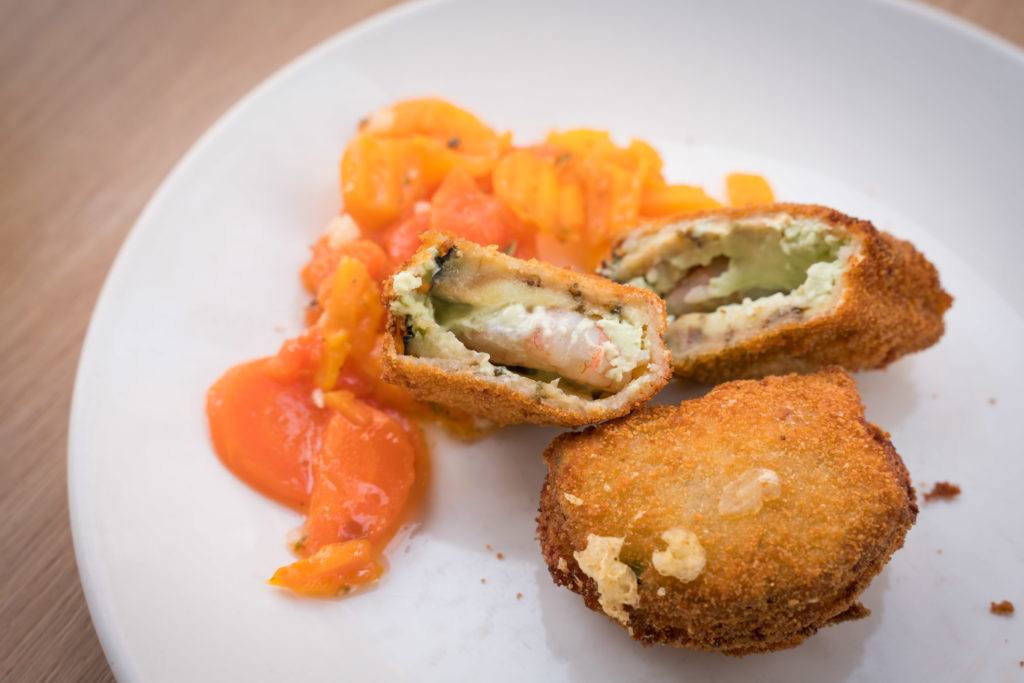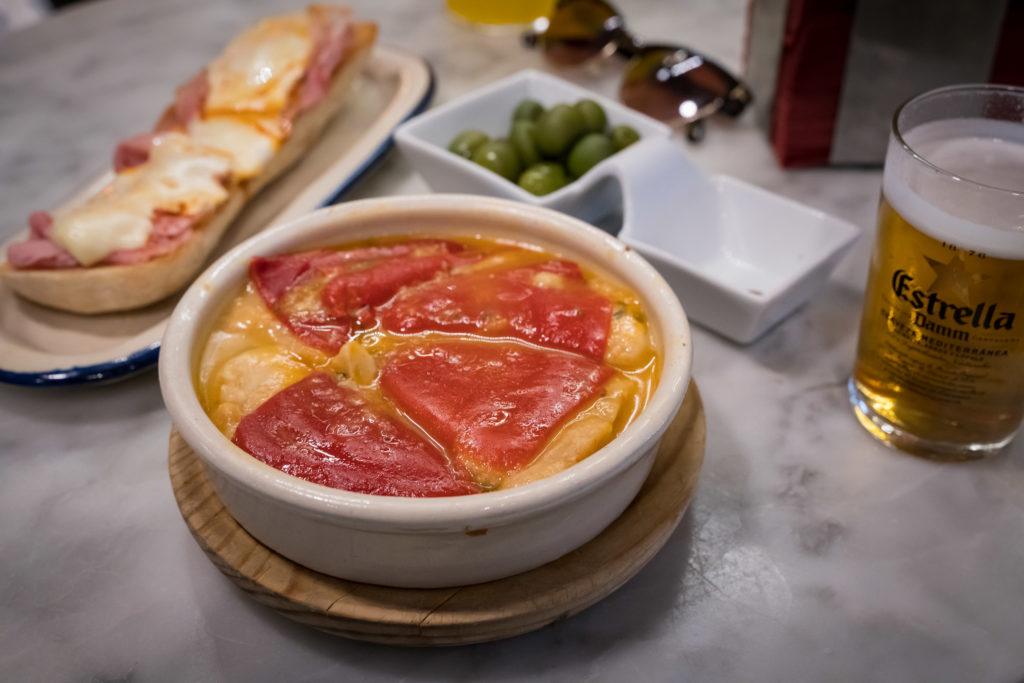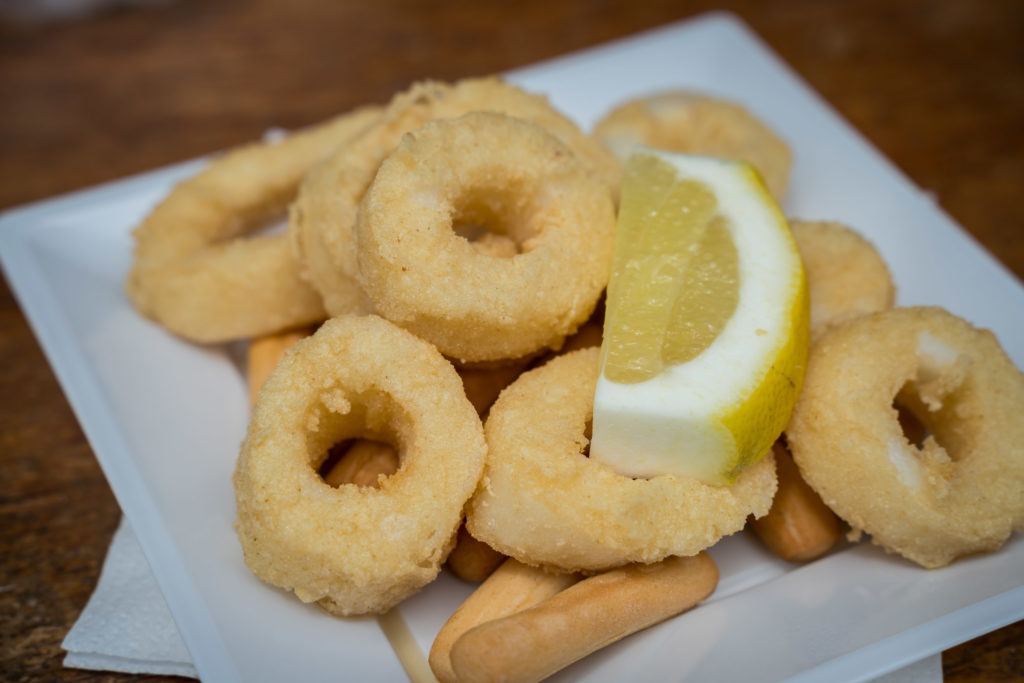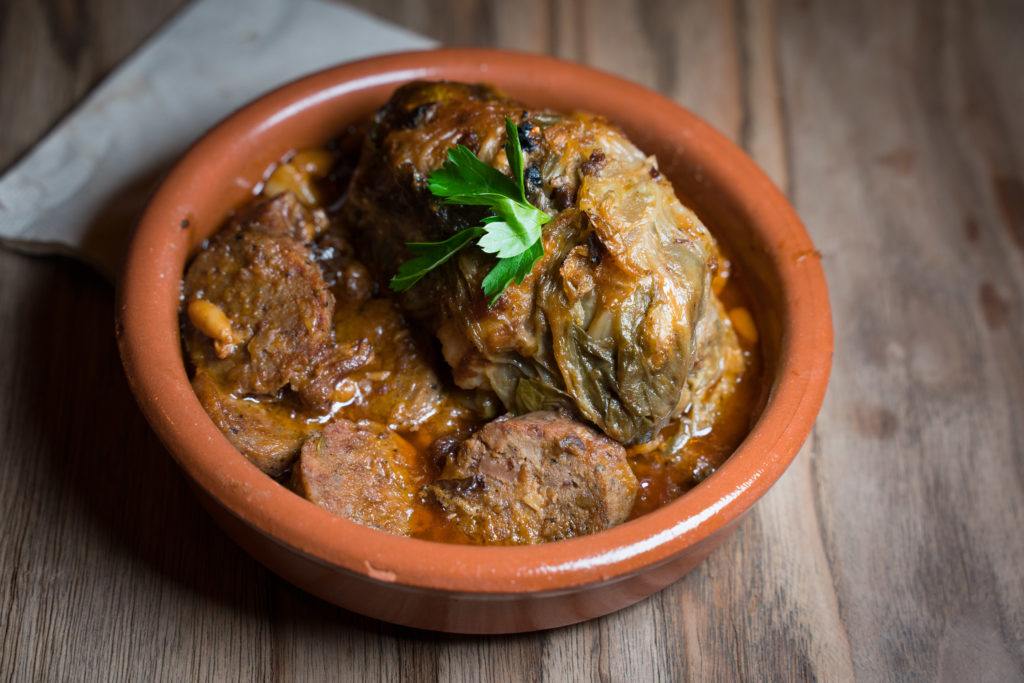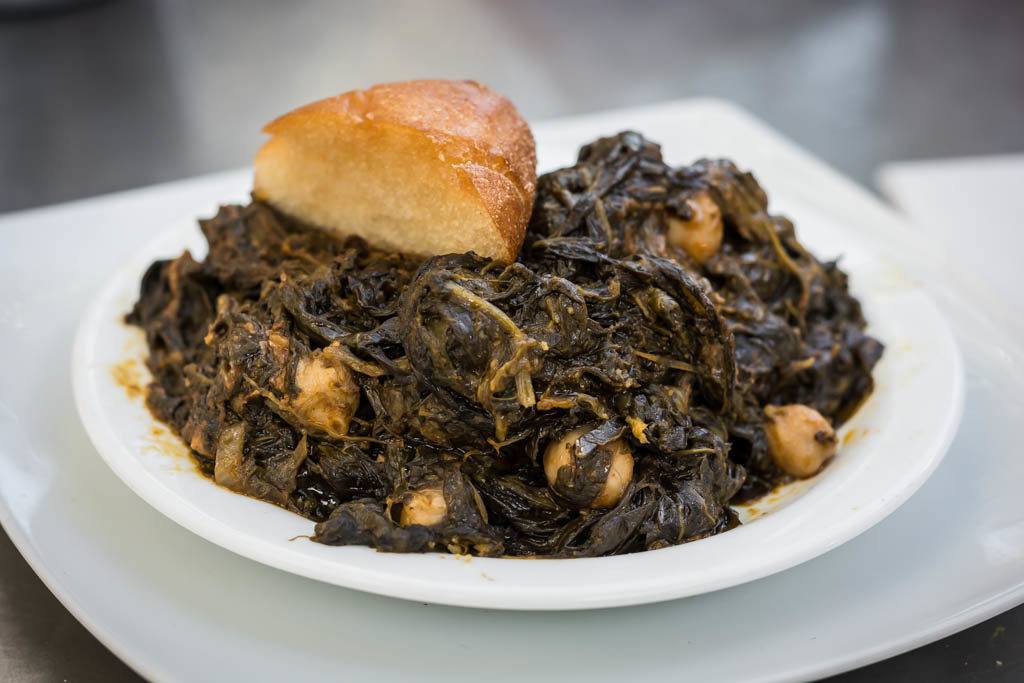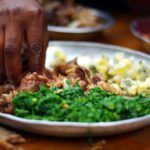History of Tapas & The Best Spanish Tapas Dishes: In this article, an introduction to Spanish Tapas culture and the much debated historic origins of tapas. 8 different theories on the history of tapas! Plus, we explain some of the other tapas styles from parts of Spain, like the history of Pintxos (from the Basque country) and of Montaditos (from Andalusia).
We explore the history of some of the most famous Spanish Tapas Dishes – like patatas bravas (spicy potatoes) and albondigas (Spanish meatballs). You’ll also find a shortlist of the most essential classic tapas dishes we think you should eat in Spain, as well as our top 10 specific Spanish tapas dishes from tapas bars around Spain that we have visited.
History of Tapas & Best Spanish Tapas Dishes – Table Of ContentsHistory Of Tapas And What Is Spanish Tapas Typical Spanish Tapas Dishes – Short List History of Tapas & Pintxos Podcast History Of 5 Famous Spanish Tapas Dishes + Recipes Our list of our favourite 10 Spanish Tapas Dishes from visiting Spain, where to find them + recipes What to eat in Madrid – 25+ dishes to try (opens in New Tab) Disclaimer: This article contains revenue generating links. Please support our blog by making bookings through our links & ads, rather than searching our suggestions on google. Our opinions are our own and we provide an honest review, not an advertorial. |
What Is Spanish Tapas?
Tapas are Spain’s traditional small plate snacks.
The word “Tapa” literally means “a cover” “top” or “lid”, derived from the infinitive “Tapar” meaning “to cover”. – and the idea of a dish that “covers” is a common thread to many tapas origin stories we’ll discuss shortly.
Tapas as a term has become popular all over the world, now even used to describe small plates dishes that may not have any culinary connection to Spanish cuisine.
In Spain though, tapas is as much about the small plates as it is about the social and cultural aspects of having tapas. Tapas bars, rather than tapas restaurants are the norm because tapas is seen as something to accompany a social drink, rather than a meal you would go to eat without some social drinking. And almost all origin stories we’ll discuss see tapas as something that was offered along with ordering a drink, included in the price.
In fact, many tapas bars do automatically offer a small tapa with every drink you order. Though it has become more common in the 21st century to order and pay for individual tapa along with drinks.
Tapas is seen as a pre-meal way to have snacks with drinks before going for lunch or dinner. As it is typical for Spaniards to eat main meals late, bar hopping for some tapas may start around noon, before going to a late afternoon lunch. And tapas can also lead up to the main dinner which likely starts after 9 pm.
And I love the tapas bar hopping culture. Getting to try lots of little bites as you move from place to place. It’s a roaming degustation every night! But do we then make it to a full dinner afterward? Quite often not!
History Of Tapas
There are so many different legends surrounding the history of tapas and it’s origin. Maybe some are more likely than others, but we’ll probably never know which are the real history of tapas!
The Sick King & Drunk Peasants Theory
The oldest story for the history of tapas suggests that it was first invented in the 13th century. Whilst recovering from a sickness, King Alfonso X of León, Galicia & Castille was only able to drink and eat small quantities at a time. Accidentally creating small plate eating, similar to tapas.
Apparently, after dining this way, the king figured that always getting some food with every drink would help reduce drunken behavior of peasants and so decreed that a small snack should be served with every drink, across the realm. As peasants were poor and seemingly preferred to spend more money on alcohol, rather than buying food, this seemed like a good solution.
A close variation of this story relates to King Felipe III in the 16th century, who had the same idea that snacking while drinking would reduce drunkenness, and forced bartenders to serve snacks with drinks.
Both stories are more legend than definite fact and they may be precursors to the style of tapas dining, even though it would not have yet been called tapas, for reasons we’ll see in other stories below.
The Illiterate Patrons Theory
This theory suggests that in the 18th century, or a little before, innkeepers and their patrons were generally illiterate, meaning that most innkeepers could not write out menus, and no one could read them if they did! Instead, innkeepers would take small samples of their main dishes around for patrons to try, served on the lid (tapa) from the pot they were cooked in.
My question would be, why not just speak to patrons and inform them of what dishes were available? That said, taste testing is a good way to sell food, so that could also have been the reason for the samples.
The Spanish Inquisition Porky Test Theory
One slightly off the wall theory is that small plate servings of pork based dishes were used to test Jews who claimed to have converted to Christianity during the Spanish Inquisition period. If they refused to eat, then it could be seen as a tacit admission that they were purposefully avoiding non-kosher food.
This theory also has little to do with the name tapa but could have been a part of the small plates tradition moving into popular culture. Or was it already a part of the culture? So this is not an origin, just a continuation?
The Sandy Wine Theory
This story states that 19th century King, Alfonso XIII, made a visit to Cadiz in southern Spain, and ordered wine at a local tavern. Due to the windy and dusty nature of the city, the waiter served the wine with a slice of ham on top to stop the sand from getting in the wine.
The king enjoyed having some ham to eat with his wine, as well as keeping the sand out, and the people of Spain readily copied this style of having a top (tapa) on each serving of wine.
The Drunk Farmer Theory
A very simple theory is simply that farmers, who would drink all day, used to enjoy small meals with each drink to provide a constant level of energy for farm work and perhaps keep them from getting too drunk while working.
While this is probably true, I don’t see that it really fits with the essence of tapas bar culture. I don’t see it as related that people simply snack and drink at the same time!
The Seville Beverage Lid Theory
It’s said that bartenders in Seville would serve sherry, beer or wine with a saucer on top in order to keep the flies out. They decided that if they also put a little snack on the plate that it would help them stand out as a better place to come and drink, as patrons got some free snacks. It worked, and bars giving out these free snacks with their drinks got way more people through the doors.
The side benefit being that some salty snacks made people drink more and faster. As the saucer acted as a top (tapa), so the little plates were named.
Stinky Wine Theory
Beginning in the Castile-La Mancha region of central Spain, sometime in the 16th century, tavern owners figured out a way to trick customers into drinking bad wine. By placing a free slice of strong cheese on top of each glass sold, both the smell and flavor of the cheese would distract customers from the taste of the wine. This had the secondary benefit of patrons thinking they were getting something for free from the generosity of the bar owner…
The Busy Bar Theory
The most basic theory of all. Simply that there has been a tradition of busy, standing room only bars in Spain. With customers having little space, standing at counters, anyone who ordered a snack didn’t have much space to put their little plates, so put them on top of their drink.
Typical Spanish Tapas Dishes – Short List
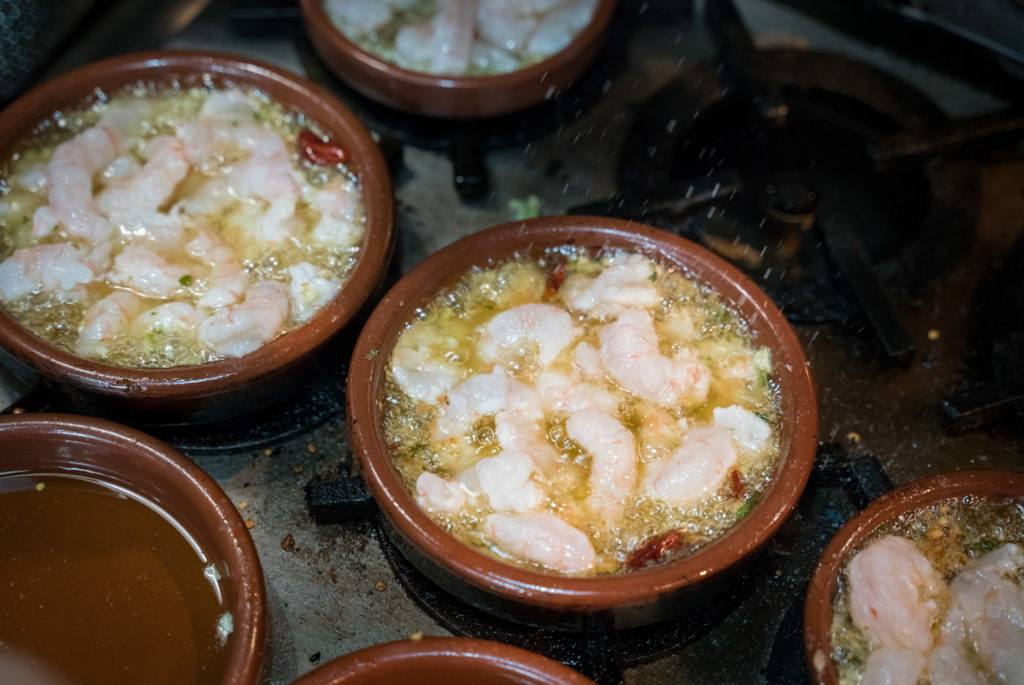
Typical Spanish Tapas Dishes: Gambas al Ajillo – prawns flash fried in lots of garlic laced olive oil
A quick roundup of some typical Spanish tapas dishes that you’ll find on Traditional Spanish tapas bar menus:
The oldest/original Tapas dishes that started the tapas tradition are believed to be:
- Jamon Iberico / Serrano – Cured Spanish Ham
- Cheese
- Bread
- Aceitunas (Olives)
Traditional Spanish Tapas Dishes you’ll find on a lot of menus across Spain:
- Tortilla de patatas – the Spanish omelette.
- Boquerones – White anchovies served in vinegar (boquerones en vinagre) or deep fried
- Gambas al Ajillo – prawns flash fried in lots of garlic laced olive oil
- Calamares Fritos – Fried calamari rings
- Albondigas – Meatballs in sauce. Though the dish likely existed before tapas did, it became a taps favorite in small portions.
- Patatas bravas – Chunky fried potatoes with a spicy sauce
- Croquetas – Spanish croquettes
- Pimientos de Padrón – deep fried little spicy peppers
- Pulpo a la gallega – Galician style boiled octopus with potatoes and paprika
- Solomillo al whiskey – Pork or beef medallions cooked in a boozy sauce
- Tortillitas de camarones – prawn cake fritters
This is far from being an exhaustive list, and many local regions will have their own popular tapas dishes. But this list gives you a good indication of the sort of Spanish Tapas Dishes to look for if you want a real taste of Spanish culture.
More dishes and their histories below, as well as our top 10 list of our favorite Spanish Tapas Dishes we tried in Spain, and where to eat them.
History of Tapas & Pintxos Podcast
In the first part of this triple Episode:
- The many theories on the origin of Spanish Tapas – 8 different origin stories!
- Plus, What were the very first tapas dishes?
In the Second Part Of Our Spanish Tapas Feature double episode:
- The history of 4 of the most famous and historic tapas dishes:
- Gazpacho soup, Albondigas (Spanish meatballs) Patatas Bravas (Chunky potatoes with spicy sauce) and Croquetas (Spanish croquettes)
In the third Part Of Our Tapas Feature triple episode:
- Tapas or not? We discover other small plate dishes from Spain – Pinchos, montaditos and more.
- The story of Pa amb tomàquet (Catalunya’s favourite simple tapas dish)
- PLUS our top 10 favourite ever Spanish tapas dishes and where we ate them.
Listen to other foodie episodes of “The Dish” on the below networks:

Listen & Subscribe: Apple Podcasts | Spotify | Google Play | Stitcher
RSS: https://feeds.captivate.fm/thedish/
Support: Become a Patron | Tweet: @foodfuntravel | Email: [email protected]
⇒ Click here to discover some fantastic Tours in Spain for yourself.
History Of 5 Famous Spanish Tapas Dishes + Recipes
5 incredibly famous Spanish Tapas Dishes that have interesting stories behind them.
History Of Tapas: Patatas bravas
One of Spain’s most common tapas. Chunky fried potatoes served with a spicy sauce. The variation on the size of potatoes or the style of the sauce is immeasurable. Every bar seems to add their own twist.
It’s definitely the sauce which makes this dish famous. bravas means “brave” referring to the bravery needed to eat the spicy sauce. And we’ve had everything from a thick tomato based sauce to things which closer resemble a spiced mayo. Served on french fries, wedges, cubed potato, and any other type of fried potato you could concoct.
So, for a humble dish like patatas bravas, is there an origin story? Maybe there is…
If you hit up Wikipedia in English, it’s a complete dead end. Some vague message about the origin story being unknown. As so often happens in our research, you have to look things up in the local language.
Spanish Wikipedia has a lead. A recipe book called El Practicón from 1893 by Ángel Muro. The reference suggests that Patatas bravas is the potatoes of the poor, and includes fried potato with a spicy sauce. However, scouring this book, which is available free on google books, although the patatas a lo pobre – potatoes of the poor – is a listed recipe, no mention of las bravas sauce is in that recipe, and no mention of patatas bravas seems to be present in the index or with the use of a search.
It’s odd that there is a direct quote from this book on Wikipedia, but no reference to the page number where it came from. Suspicious!
The next claim is from a Madrid restaurant called “las Bravas”. Supposedly established in 1933. Originally a wine tavern which converted into a tapas bar after the Spanish civil war which ended in 1939, so the bar changed sometime between 1939 and the 1950s, apparently.
It’s not clear if the bar has always been called las Bravas – but having a bar called “The Brave” seems like a possible name that could have been around for a long time, not necessarily something that was changed at a later date.
In the 1950s they began to serve chunky potatoes with a house spicy sauce – the las bravas sauce. At this point, you might question that this story seems a little too good to be true. But, then, they actually patented the sauce in the early 1960s and they own the registered trademark since then.
When you look at it like this, being that no one else owned the patent before them, that the name of the bar existed before the sauce, and that the sauce took on the name of the bar, then the “brave” part of the name may have had nothing to do with it being spicy, but actually just a fortunate coincidence that helped it become a national favourite.
Although potatoes of the poor may have been served with spicy sauce long before Las bravas patented their recipe, they certainly have the strongest claim to a documented history of the sauce. The name spread around the country from the 1960s, so if nothing else, they inspired the new naming of the dish. | See Recipe
Spanish Tapas Dishes: Croquetas
Another food of the poor, originally at least, is definitely the Croquette. In Spain, called croquetas.
A deep fried, bread ball or cylinder of leftovers or cheap ingredients, fortified with just a little bit of a higher priced ingredient, like Serrano ham, chicken, cod, mushrooms or prawns and often held together with bechamel sauce or a brown sauce.
Officially croquettes were invented or at least formalised by Auguste Escoffier in 1898. Known as one of the kings of French cuisine, Escoffier is said to have modernised traditional French haute cuisine. As executive chef at various internationally historic venues, such as the Ritz Paris, and the Savoy London, he is credited with inventing dishes like the Peach Melba. The Croquette seems to be more of a re-invention, than an original as similar dishes likely existed in Jewish cuisine at least since the 17th century. There are even some claims that something similar to a potato croquette was being made in South America before Spanish colonization.
As for written records, The Steward’s Handbook and Guide to Party Catering ©1889 is a cooking manual written in the USA. It states “CROQUETTES—The word signifies something crisp. Croquettes are balls or any shape of almost any eatable thing, floured or bread-crumbed and fried in plenty of hot fat, then drained on paper.” and goes on to describe fillings and ingredients that all sound very much like what any modern croquette would be.
The Godey’s Lady’s Book of Receipts and Household Hints” ©1870 details the recipe and method for potato croquettes that is almost identical to what you’d expect a modern recipe to be.
Menus from The Fifth Avenue Hotel, New York, clearly detail croquettes as being available at some point between 1859 and 1865. So, whoever originally invented croquettes seems lost to history, but the word, being of French origin, may suggest a modern form of them was invented in France long before Escoffier re-codified their preparation in 1898, and then transported to the US and popularised under that name, even though similar dishes may already have existed.
The most famous type of croquette is probably the potato croquette. Served in canteens, as a side dish, and in many other formats worldwide. But much more interesting versions exist, especially as part of the Spanish tapas scene.
Rather than boring old mashed potato croquettes, you’ll find croquetas filled with a rich, gooey sauce laced with serrano ham. Or, potato versions with cod or prawns. A perfect bite to be enjoyed on its own, rather than a side dish.
Though every restaurant has there own take on the classic Spanish croquetas, be ready to bite into them and almost spray searing hot sauce all over your shirt, if you are lucky enough to get a gooey one, rather than a potato filled one. Yum! | See Recipe
Spanish Tapas Dishes: Gazpacho / Salmorejo
Red Gazpacho is a cold soup made from tomato and other vegetables like cucumbers and peppers and thickened with breadcrumbs. It’s a soup served cold, perfect to refresh on a hot Spanish summer’s day. But this most famous sort of cold Spanish soup was certainly not the original, with tomatoes being added only since the 19th century. And the world famous red gazpacho is only one type of cold soup from the region, with other featuring differing ingredients.
It appears the original soup made with breadcrumbs may actually have been a typical food choice of Roman legions as they spread their influence across Europe. bread, garlic, salt, olive oil, and vinegar would be mashed into a paste. Very little other information seems to be available on this recipe choice. Presumably, water would be mixed to turn the paste into soup. So perhaps this original would have been a hot soup, as the water was not safe to drink in most places without boiling first.
These base ingredients feature in all the traditional preparations, Legend has it that this base paste was even carried by Columbus on voyages to the Americas. Some modern variants now seem to leave out the bread to make them lighter, though purists would argue that it is not Gazpacho anymore!
A similar style of soup making is said to have arrived in southern Spain during the occupation of the Moors from North Africa, who took over the region from 711 AD. Their similar soup had the addition of almonds into the ground paste. But, given the date of arrival, and the influence of Rome over North Africa before these dates, the Moors version may have been due to Roman influence in the first place.
The ajo blanco soup from Malaga might have its roots in the Moorish style, as it is made with crushed almonds even today and plenty of garlic. It’s often balanced with the addition of some sweet fruit like melon or grapes, depending on the season.
I mentioned before the salmorego, from Cordoba. Unlike the lighter Red Gazpacho, which is typical of Seville, the salmorego adds only tomatoes, no extra veg, and no water, so it comes out really thick! It’s often garnished with Iberico ham and cubes of boiled egg. | See Recipe
History Of Tapas: Albóndigas
Albondigas are Spanish meatballs served in a sauce or gravy. A classic tapas that we love! And you’ll find them in varying forms all over the Spanish speaking world.
Not surprisingly, meatballs evolved in many cultures quite early on. It’s a great way of using up less choice cuts of meat, or old or tough meat that could then be tenderised and improved through chopping and flavoring.
An unconfirmed reference suggests the oldest meatballs were made back in china, in the Shandong region during the Qin dynasty, around 200BC.
A more definite reference is from our old friend, the book Apicius. Not the first time and surely not the last this book will crop up. This 1st century AD cookbook details huge amounts of Roman recipes.
The recommended meat for making meatballs in ancient Rome? Peacock is best, then pheasant, rabbit, chicken and pig.
Just like Gazpacho, the other big influence on southern Spanish cuisine was the invasion of the moors, who are said to also have brought their own ideas for meatballs.
The name albondigas at least is connected to the Moorish dish and Arabic term al-banadiq which may also have been pronounced al-bunduqa – which translated roughly as “The Ball You eat”
A 12th century Moorish scholar, Ibn Razin al-Tubigí, describes minced meat mixed with spices and egg whites and then cooked in salty water. Later, in the 13th century, the recipe has evolved to include garlic and might be pan fried.
But it takes until the 17th century for a recipe resembling today’s to appear, where Hernández de Maceras describes a recipe with mince meat, beaten eggs, breadcrumbs, chopped fat, garlic, herbs, and spices. He also describes regional differences.
So, the humble meatball may have first been documented in ancient Rome, or even China. But it seems like the popular Spanish Albondigas owes most of its history to the Moors occupation of Spain. | See Recipe
Catalonian Tapas: Pa amb tomàquet
Let’s move from the south of Spain to the region of Catalunya.
Pa amb tomàquet is rustic bread rubbed with tomato, and drizzled with good olive oil, and salted. Rubbing on some raw garlic is optional.
This dish forms an everyday part of life in Catalunya – that’s the region on the Mediterranean where you’ll find Barcelona and Girona. Also, the Balearic islands – including, Ibiza Mallorca and Menorca used to be a part of Catalunya, historically. It’s also popular down through the rest of the east coast of Spain – To Valencia, Murcia, and other areas. Though it’s origin is disputed, many believe it was a traditional food of Catalunya originally.
Catalan restaurateur Lluis Cruañas is quoted as saying, “in Catalunya the first thing you taste after the baby bottle is pa amb tomàquet.”. It is such a simple dish that it is often brought to the table in constituent parts, ready for the diner to assemble themselves.
Halved tomatoes are rubbed on the bread to get all the pulp and the juices and flavor out and into that bread – discarding the tomato skin. It’s common to use yesterday’s bread for this dish as it is the perfect way to re-invigorate and soften slightly hard bread, and it’s possible the first time it was made was for the same purpose – of using up old stale bread. Normally the bread is toasted before rubbing.
Competing claims over the first written recipe suggest the dish could be as old as the 18th century, or as young as 1884. Though I couldn’t find the original sources online in order to confirm these dates. But, historians conjecture that at some time there was probably a bumper harvest of tomatoes and farmers in the region decided to try a new way to use up stale bread by just rubbing tomatoes on them. Put like that, It sounds like the laziest student food on the planet. Can’t be bothered to cook, just rub tomato on some old bread.
I can imagine a group of old Catalonian farmers sitting around drinking wine, reminiscing about the year they had too many tomatoes and so they just rubbed them all on bread, while their wives started calling them idiots. But, it all worked out!
Want more Spanish Food history? We discuss the history of Tortilla de patatas (Spanish Omelette) in our what to eat in Madrid article and podcast.
History of Pintxos (Pinchos) – Tapas From Basque Country
A pincho, which literally means “spike” in Spanish, also can refer to a skewer, brochette or toothpick.
In the culinary context of Pintxos from the tapas world, we are talking about small bites of food on a wooden skewer or toothpick. From a few little items like olives, pickles, anchovies or chilies, stack on a little toothpick, to full stacks of ingredients atop a slice of rustic bread.
The Pintxos has evolved from humble beginnings to often represent a perfect bite of flavor combinations of popular Spanish ingredients and dishes. Unlike tapas, which is normally shared between friends, pintxos are typically eaten individually by each patron. But, similar to tapas, they are supposed to be small snacks to accompany a drink or aperitif, and not to be collected in bulk to make up a full meal – though tourists all like to do it that way! Apparently it is a faux pax to pile your plate high with pintxos, instead, you should just take one or 2 with each drink.
Tapas tradition was already in full force by the 19th century, possibly long before. But the first pintxos only began to arrive on tables in the 1940’s
In San Sebastian, Basque country, during the 1920s and 30s, it was already common to enjoy a few drinks after visiting the town for shopping etc. A visit to the cider houses and bodegas was commonplace. After the Spanish civil war concluded in 1939, the habit of bar hopping, rather than just stopping in one place, became more popular.
Bars incentivized visitors by putting out a little food for them to take from the bar along with each drink. The very first pintxos were likely based on the banderilla – which refers to the bullfighter’s sword. This was essentially some pickles on a toothpick. But summer tourists from central Spain, visiting San Sebastian, started to call them Pintxos, as little spikes of food.
The most famous pintxos of the time were called the GILDA said to be inspired by the 1946 film noir of the same name. The dish is a skewer with an anchovy, olive, and hot pepper. These were selling for the equivalent of about 2 cents a stick. The connection to the movie is unclear to me. Maybe olives and pickles on a toothpick in a cocktail, like a martini? I can’t find any info on that.
From the 1960’s the name, pintxos begins to gain popularity. More complicated offerings start to appear and the idea spreads to other parts of the region. And into the late 1980’s and 90s, Pintxos develops to be more than just little snacks at the bar and become miniature works of art which represent main course dishes. At the same time, the idea of pintxos made with multiple ingredients held to a slice of bread with a small skewer, rather just ingredients on a stick becomes popular.
into the 21st century, pintxos gain nationwide and then worldwide popularity. And as the San Sebastian becomes a world renowned food destination, the pintxos takes a place in fine cuisine, as well as maintaining its roots in bars.
Although pintxos may be found made to order, any of the more old school places which have them on the bar are likely to have an honesty system where they just count up all the skewers left on your table at the end of the meal. Each skewer may have a colored indicator attached so they know the value of the item
A pintxos with bread may be topped with Chorizo, or sausage and sweet pepper. Maybe manchego, roasted peppers, and an anchovy. Or a much more complicated combo. So many possibilities!
What Are Montaditos? A Tapas Style From Andalusia (South Spain)
Montaditos are essentially a very similar concept to the pintxos on bread from Basque, but montaditos come from the south of Spain, originally the area of Andalusia and they appear to have evolved independently. Montaditos usually would not have had the toothpick to hold them together, and normally they only focus on simple and cheap and don’t have much focus on the high end food market.
The Spanish verb Montar means “To Ride” or mount. So montaditios derive from the idea that ingredients are mounted on little bits of bread.
Our list of our favourite 10 Spanish Tapas Dishes from visiting Spain, where to find them + recipes
Having traveled a lot around some of Spain’s greatest tapas cities, we’ve tried plenty of excellent tapas over the years. Here are 10 Spanish tapas dishes that are worth traveling for, as well as some tapas recipes you can check out if you want to make your own versions at home.
Carrillada de Cerdo en tinto @ La Bodeguita de Plocia (Cadiz)
Pork cheeks in wine is certainly a classic tapas, this was our favourite version so far. La Bodeguita de Plocia is a tapas bar specializing in Iberico pork served in many different ways.
This dish has a rich sauce with soft and delicate pork cheeks. Their version really wowed us for perfect balance and good tasty meat. I like this dish best with pork cheeks, rather than beef cheeks which you may find elsewhere. There is no real history as such for this dish. If you have pork, wine, and garlic, which Spain has in abundance, it’s obvious to combine them! | See Recipe
Octopus en Ragut @ Loli (Triana Market, Seville)
Possibly one of our favourite ever tapas dishes. At Loli, right at the back of the Triana market in Seville, the take crispy grilled octopus tentacles and finish them quickly in a tomato ragu, similar to ratatouille. An unusual and fantastic combo. | See Recipe
Chorizo filled button mushrooms @ Meson de Champignon, Madrid
We talk about Meson de Champignon and the history of traditional inns in Madrid in our what to eat in Madrid article. Suffice to say, hotplate grilled mushrooms filled with olive oil, chorizo, butter, and herbs are just awesome. Stuffed mushrooms are a common tapas item, but I’ve never had anything quite like this gushingly juicy preparation.
Berenjenas rellenas con gambas @ Blanca Paloma, Seville
A twist on stuffed eggplant, and croquetas. At Blanca Paloma in Seville, a prawn in a creamy sauce is wrapped in eggplant, coated in breadcrumbs and deep fried. Also a less common tapas than regular stuffed eggplant, I loved this version!
Pimientos de Piquillo Rellenos @ Casa González, Madrid
Prawn and cod stuffed piquillo peppers. Piquillo peppers are traditionally grown in Northern Spain near the town of Lodosa. They are 100% sweet, with no heat at all. At Casa Gonzalez, the puree bacalao (cod) and prawns with spices to make this succulent seafood filling.
Calamares @ DKY freiduria de pescados y mariscos (Cadiz municipal market)
I’ve never had calamari as fresh, soft and succulent as in Spain. If you are used to ordering skinny little calamari rings at your local pub. Forget it. That’s not real calamari. Firstly, a lot of cheap calamari is made with squid. Calamari is a slightly different, but very similar species. Also, in Spain, it’s normally super fresh, especially if eating in coastal areas, and they do really chunky rings.
At the municipal market in central Cadiz, we found DKY freiduria de pescados y mariscos, a market stall only selling fried seafood. Their Calamari was perfect. They are not the only place I’ve had calamari this good in Spain, just the most recent and I can’t separate the quality of any of my favourites. | See Recipe
Lomo con col @ Mercat 1930, Palma de Mallorca
Palma, the capital of the island of Mallorca, has its own unique history of food. We talked about this in depth in our what to eat in Mallorca article and podcast.
Lomo con col is pork and sobrasada – Mallorcan chorizo – wrapped in cabbage, stewed with morcilla – blood sausage. It’s a pork lovers’ delight. Eat at Mercat 1930 | See Recipe
La Bomba (Bomb) in Barcelona @ L’ Anxoveta
A more advanced version of croquetas. La bomba means “The Bomb”, it’s round like an old fashioned bomb from cartoons, and the idea is when you bite into this, it explodes, not only because of the optional hot sauce it sits in, but because, rather than just a regular croqueta with meat blended with potato, it’s a ball of potato with a meaty surprise right in the centre.
It was invented at La Cova Fumada in Barcelona in the mid 1950’s, and the official naming story arrived, apparently, due to one of the first customers who tried it exclaiming “Wow! This is a bomb!” due to the unexpected hot sauce.
Whatever the origin story, the idea was copied and now appears in many tapas bars around Barcelona. We suggest L’ Anxoveta in Gracia, but you can also still try the original at La Cova Fumada in Barceloneta
Espinacas con garbanzos @ Los Cuevas, Seville
Chickpea and spinach tapas. Both spinach and chickpeas, as well as cumin, made their way to Spain via the same invasion of the Moors we’ve mentioned many times. This dish typically blended with bread crumbs, vinegar and ground almonds shows a real fusion of Spanish and Moorish and is a famous tapas in Seville. I love this dish and often make at home too as it seems to be much less easy to find outside of Spain. Eat at Los Cuevas. | See Recipe
Want to learn more about Spanish food?
Read Our Related article: What to eat in Madrid – 25+ dishes to try. – Podcast & Article.

